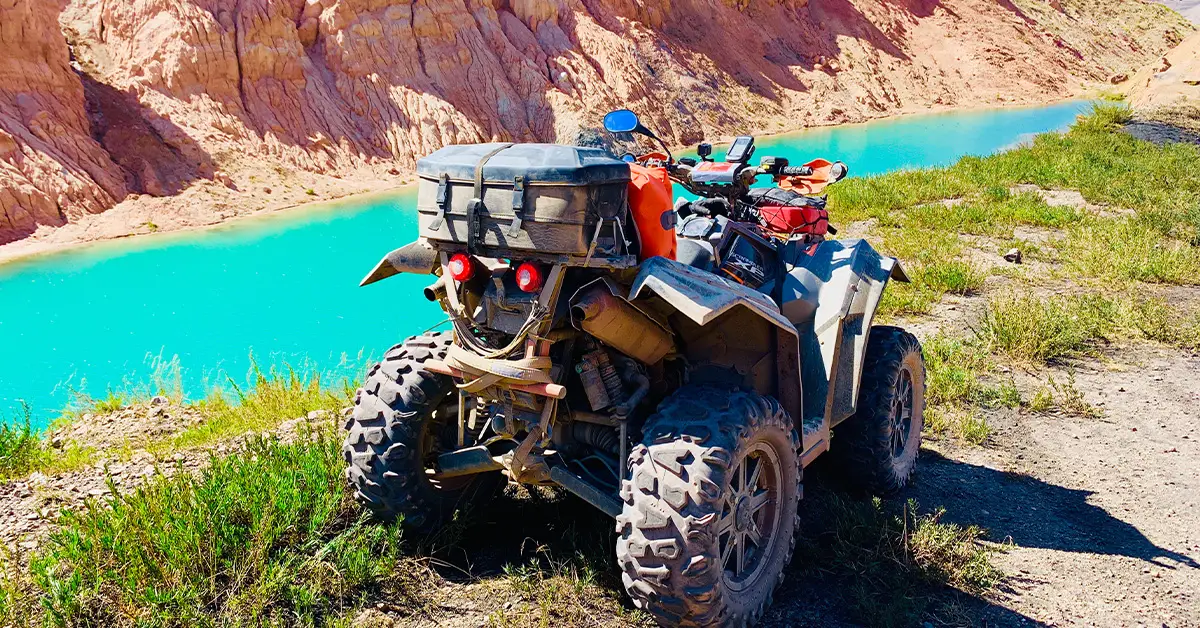Overlanding enthusiasts and riders that love exploring new lands can always explore new areas on their ATVs. The Honda and Polaris ATVs carry the day if you want the best ATVs to help you survey new areas. Even though Suzuki and Kawasaki are viable options and come with great models, the Honda and Polaris are superior when it comes to Overlanding. Many people find it hard to choose between the Polaris or the Honda ATV for their Overlanding itinerary.
That is because these two are top brands and their ATVs are perfect for off-road adventures. These brands offer users engaging experiences off-roading due to their unique features and characteristics. This guide looks at the differences between the two ATVs and their features. Follow along to discover the differences.
Table of Contents
Power
Looking at power, the two ATVs have different engines even though both are fuel-injected and liquid-cooled. Honda engines have a cap around the head with pushrods responsible for controlling the valves. However, some Polaris models have a dual-overhead-cam design. Note that Polaris and Honda do not have front differential locks. Polaris bears more power due to the AWD system. This system is perfect for ATVs because they can lock the front diffs.
The Honda ATV engine comes in a 475cc liquid-cooled, single-cylinder, longitudinally-mounted, four-stroke engine. This engine model was updated lastly in 2015 with few improvements. The engine is a 29-horsepower engine.
Polaris engine comes with a 2.0-liter twin-cam four and also has 178 horsepower. The R model bears 203 hp at 8250 pm.
Handling
When talking of the handling department, the Polaris ATV is superior to the Honda. Polaris bears better suspension, making the vehicle efficient when traversing via rocky terrain. The ATV will easily conquer new lands and different terrains with superior suspension. The Polaris also has larger diameter tires that enhance its handling and stability.
Larger diameter tires mean the ATV has more grip on the road. A larger diameter increases the contact area between the tire and the road. That boosts your ability to maneuver and the overall stability of the vehicle. Polaris ATV bears 14-inch wheels, which are also great for handling and maneuverability.
It is easy to come across Polaris ATVs with electronically powered steering. Most Polaris ATVs will have dual hydraulic disc brakes, while the Honda will have a single rear hydraulic disc. That makes Polaris more efficient when it comes to handling compared to the Honda ATVs.
If you carefully assess the Honda suspension setup, you will agree that it deploys an independent double-wishbone and one shock behind the swingarm and the rider.
Riding Experience
ATVs are known to offer riders an explosive riding experience. Any rider will tell you they enjoy every moment on top of an ATV. Both Polaris and Honda will offer users an immense riding experience. However, compared to Polaris, the Honda ATVs come with a lower seat height.
That also means its handlebar will be lower to match the seat height. It gives you comfort when seated. The only significant issue here is withstanding. The rider will have a rough time reaching the handlebars while standing. That is because of the low seat height and handlebars. Honda ATVs do not have advanced controls, and this is where Polaris edges.
Polaris ATVs come with better handlebar control. The handlebars are also high enough, which gives the rider an easy time even when they wish to stand on the bike as they explore. The ATV has enhanced handlebar control and a very minimalistic setup. That means you will easily concentrate on your explorations and the road ahead rather than try to find the lights button in a plethora of buttons on the handlebar.
Style, Color & Accessories
Both ATVs come in diverse colors. Riders can choose any color they wish to purchase. Honda may come in olive and red colors like the Honda FourTrax Rancher, and the Polaris comes in Velocity Blue Sage Green colors. Survey the market to find your ideal color, Polaris or Honda ATV. When talking about style, both ATVs bear stunning designs.
They are good-looking and attractive ATVs that every rider would want to set their hands upon. However, Honda ATVs come with more accessories than Polaris in terms of accessories. These accessories in Honda may be suspension guards, pocket nets, windscreens, power blades, and winch mounts. All these make the Honda more desirable in terms of accessories that come with the ATV.
Creature Comfort
Both Polaris and Honda offer users standard rider options. However, the Honda does not have ample storage space compared to the Polaris. Honda ATVs have smaller storage compartments that cannot hold many items. A good example is the rubicon 500 eps; the rider can only store their wallet, keys, or water bottle on the left-side front fender. The rear does not have too much space either for storage.
The Polaris ATVs come with around 8 gallons of storage. Its storage areas are well integrated into the ATV and held in place by locking latches.
Both ATVs come with digital dashes. The Honda ATV dash has a gear indicator, hour meter, maintenance level, speedometer, odometer, 4WD indicator, fuel gauge, clock, coolant level, and trip meter. Polaris dash has more items, including a tachometer, speedometer, hour meter, voltmeter, fuel gauge, gear indicator, coolant temp, clock, hi-temp light, and AWD indicator. Both bikes come with a DC outlet standard.
The two quads come with three headlights even though the Honda has a single brake light, while the Polaris comes with two. Their ergonomics feel stunning. However, many riders seem to love Hondas because of the leg area. The Honda ATV has a narrower leg area compared to Polaris. As mentioned earlier, Polaris is better in terms of the handlebars while standing. Both machines come with large footwells and plush seats.
Performance
Polaris has an electronic fuel-injection system that gives the ATV 44 horsepower. It also comes with four valves for every cylinder to enhance efficiency. On the other hand, Honda uses Honda’s Programmed Fuel Injection system producing 28 engine horsepower. Polaris ATV has lots of low-end grunts and smooth powerbands. Polaris will easily maintain a balanced rpm range on climbs and even while traveling on long roads that have multiple turns.
Hondas will start strong during the beginning of the climb but will reduce in power as they reach the top of the climb. The Honda could clock top speeds of 34 mph during the climb, while the Polaris could get up to 45 mph. Understand that Hondas are lighter, meaning they have better responsive power steering. That makes Hondas more playful and nimbler than Polaris.
Both quads come with unique hydraulic brake systems. The Honda has two front calipers that are controlled from the handlebars using a lever on the right-hand side. Two rear calipers are controlled by levers found to the handlebar’s left and a foot lever found on your right. Polaris ATV comes with one master cylinder that controls all three calipers.
So, if you are still asking, is Polaris ATV better than Honda? You have your answers from the article. Polaris quad has one rear caliper and not two. It comes with a foot pedal that controls the rear brake caliper. However, the Polaris brakes better with less effort, even with a single rear brake caliper.
To expand more on the handling, when cornering, the Polaris seems to have a disadvantage over Honda. Hondas cut tighter corners and remain stable compared to the Polaris. Polaris feels balanced and stable on the fast corners. While riding on wooded and rocky areas, Honda makes quick routes and moves perfectly, but the Polaris cannot make quick turns in such terrain.
Polaris comes with a balanced demeanor on fast obstacles like off-camber ruts or whoops in terms of suspension. The Honda poses a challenge holding the front end up and could easily get out of shape. Polaris wins over large terrain like rock fields and boulders. The good part is that both quads have good ground clearance.
Payload
The rear and front rack capacity for a typical Polaris would be around 180 lbs and 90 lbs. The total payload for the Polaris is about 500 pounds. Honda is less liberal with the capacity ratings. Its typical rear rack capacity is around 133 pounds, while the front rack capacity is about 66 pounds.
Pricing
The pricing of these two quad bikes will largely depend on each quad’s features. The price range for Polaris is between $6,399 and $6,999. A good example is the Polaris Sportsman 450 H.O which goes for $6,399, while the Honda Rancher 4×4 goes for $6,499. Honda ATV base prices are $3,199 and could go up to $9,499. The choice is yours to decide whether you want a quad with a unique suspension and powertrain over a quad with outright payload and ground clearance.
Final Thoughts
Many riders always ask, is Polaris ATV better than Honda? The answer to the question boils down to personal preference and choice. Each of these quad bikes has their advantages and disadvantages. Follow the guide to learn more about each of these quads.










